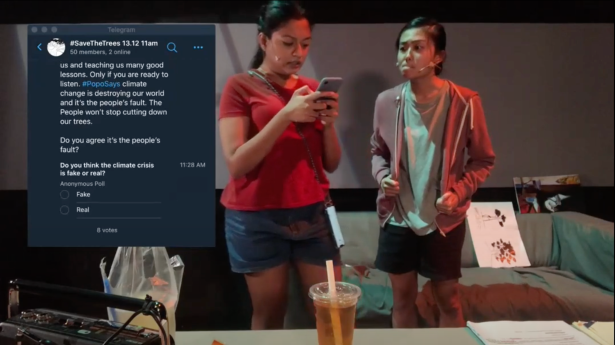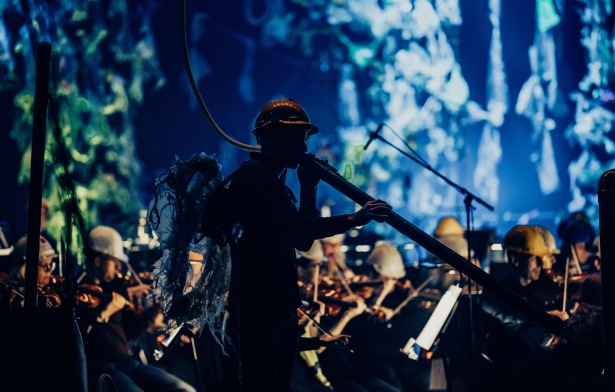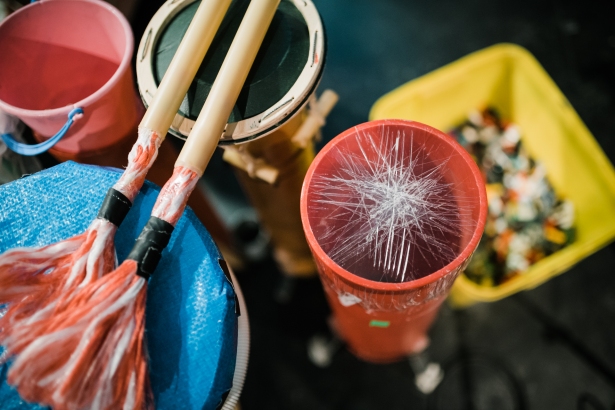Xiao Ting is a freelance Singapore-based hyphenated practitioner – performance-maker, movement-based performer, actor, educator and interdisciplinary collaborator. She was a recipient of the Singapore National Arts Council Undergraduate Scholarship and graduated from Lancaster Institute of Contemporary Arts (LICA), Lancaster University, UK, where she received the LICA prize for Outstanding Achievement in Theatre. She is currently an Associate Artist with The Theatre Practice (Singapore) and Programmer for Practice Tuckshop.
How did your interest in eco-theatre and eco-scenography begin?
I absolutely love hiking and trekking in the mountains (responsibly, of course!). Climbing Mount Rinjani (Indonesia) and completing the Annapurna circuit (Nepal) were two of the biggest highlights in my life. It was only a matter of time before I started thinking about integrating two of my greatest passions – the natural environment and theatre.
What does ecoscenography or eco-theatre mean to you? How do you define it (for yourself and others)?
I believe that Eco-theatre is about harnessing the power of theatre to advance a slowly-but-surely cultural shift. For me, theatre is a space for stories. Theatre is a space for hope and transformation. There’s already so much good work by local communities about how to contribute in meaningful ways that I think the best thing theatre can do is to be a bridge – to empower or motivate people to care, to think differently and take action in their own ways.
Eco-theatre is as much about creating work, as it is about ethics in collaboration. So much of our work also involves fostering meaningful relationships to build a healthy ecosystem that we can create within. For example, how do we embed environmental sustainability into our operations, logistics and creative practices?
In my practice, I use an interdisciplinary approach to create work that inspires climate action. I want to create different ‘access points’ for specific audiences. This means each work will look very differently, depending on the audience. Therefore, I am always on the lookout for inspiring collaborators around the world who may vary differently in art form, but stem from the same ethos.

Can you tell me about your latest project, Poppy?
Poppy was inspired by the ‘Greta Thunbergs’ of the world. It was also written in response to Kuo Pao Kun’s ‘The Silly Little Girl and The Funny Old Tree’. We wanted to maximise the potential of digital theatre to create a live-streamed hybrid performance of film/animation/theatre specific for young people (14-18 years). So, we ended up with Poppy – a story of an adolescent environmentalist, who goes on a journey navigating the complexities of climate action and social media activism culture.
Through the use of social media platforms such as Telegram and Instagram (@p0_ppys_ok123), we positioned our young audiences as social media followers, so they have to experience and witness the complexities of talking about the climate crisis online. They experience first-hand, how easily it is to say something in an effort to ‘do something’, and how challenging it is to follow-up with meaningful action.
As the majority of Singapore youths are ‘city kids’, this entry point for climate action is familiar. This means that we were able to engage them in deeper conversations at the post-show segment.




Can you tell me about your longstanding projects, Recess Time and c o o p?
Food waste is one of the biggest waste streams in Singapore and the amount of food waste generated has grown by around 20% over the last decade. In 2019, Singapore generated around 744 million kg of food waste. That is equivalent to 2 bowls of rice per person per day, or around 51,000 double decker buses. As most food in Singapore is imported from overseas and bought in supermarkets, consumers are used to purchasing unblemished produce. In order to de-stigmatise ugly produce, we created Recess Time!
Recess Time is a lunch party at the heart of the Singapore arts district. It is a long-running participatory work that stages a social situation, i.e. lunch, as the site for public engagement. It has served 30 lunch sessions to date. For this programme, invited chefs go on rescue missions to salvage unwanted or ugly produce. They then incorporate the rescued produce in their menu. Each Recess Time also features a “Kaypoh†King/Queen, whose main job is to archive the conversations that emerge from a lunch like no other.

Meanwhile, audiences also get to enjoy their food in the premises of Practice Tuckshop(@practicetuckshop) or on c o o p – a multi-level outdoor installation created by DO Agency with support from Nanyang Polytechnic. This reusable modular architectural system was built using biodegradable strand-woven bamboo. Herbs from the solar-powered aquaponics garden are regularly incorporated into our daily menu. It was awarded the COLA Environmental Sustainability Merit Awards (2018) and the Singapore Good Design Award (2019).
Last year, Recess Time was featured in a documentary about ground-up initiatives that tackle the climate crisis in Singapore.

What were some of the biggest hurdles that you have had to tackle in creating these project/s? What are you most proud of?
Narrowing the scope of the research for each project is always daunting. The climate crisis is a global problem, but the way in which it manifests in each country is indisputably specific. To identify a focus area for each project, we start by asking:
- In terms of our local emissions, who are the biggest contributors and why?
- As city-dwellers, what is our relationship with the natural environment?
- How does that translate into practice with regards to the climate crisis?
I am most proud of the ‘sphere of influence’ each climate-focused project has generated. For instance, to be able to hear members of the creative team go: wow! I’ve always felt so much guilt about needing to do something for the environment, so I end up doing nothing. I never thought I could make a difference…

What tips would you give to a theatre maker who is exploring eco-theatre and sustainable practice for the first time?
I read an article by Jonathan Franzen (The New Yorker) and it really resonated with me. Franzen writes:
“In times of increasing chaos, people seek protection in tribalism and armed force, rather than in the rule of law, and our best defense against this kind of dystopia is to maintain functioning democracies, functioning legal systems, functioning communities. In this respect, any movement toward a more just and civil society can now be considered a meaningful climate action.â€
So I would start this exploration by first asking: As a (insert role), what is a possible ‘meaningful climate action’ for me and my community?
Also, as someone who struggles with climate depression, I also think it’s about constantly reminding yourself that there is hope for the future because every bit counts!!!
What do you think the future of theatre will look like for a climate-resilient world?
I think it will be come increasingly collaborative. Practitioners will find more reasons to do work online as geographical borders will become increasingly irrelevant, also because the amount of carbon footprint in air travel will be and has been, a serious point of consideration.
What is your next project?
I am currently in the midst of translating Poppy and doing a Chinese-language version of the work, as well as conceptualising Poppy 2.0. This next phase will include international artists who work in the intersection of theatre, education and climate action. We want to continue experimenting with Digital Theatre and bring teens from different parts of the world together on Zoom – without accumulating carbon footprint in the form of air travel!
If you are curious, find out more here.
(Top photo: Recess Time (by Ang Xiao Ting, Sim Xin Yi and Joey Cheng), Practice Tuckshop.)
The post, Community Engaged Eco-theatre Action: Interview with Xiao Ting (Singapore), appeared first on Ecoscenography.
———-
Ecoscenography.com has been instigated by designer Tanja Beer – a PhD candidate at the University of Melbourne, Australia, investigating the application of ecological design principles to theatre.
Tanja Beer is a researcher and practitioner in ecological design for performance and the creator of The Living Stage – an ecoscenographic work that combines stage design, permaculture and community engagement to create recyclable, biodegradable and edible performance spaces. Tanja has more than 15 years professional experience, including creating over 50 designs for a variety of theatre companies and festivals in Australia (Sydney Opera House, Melbourne International Arts Festival, Queensland Theatre Company, Melbourne Theatre Company, Arts Centre) and overseas (including projects in Vienna, London, Cardiff and Tokyo).
Since 2011, Tanja has been investigating sustainable practices in the theatre. International projects have included a 2011 Asialink Residency (Australia Council for the Arts) with the Tokyo Institute of Technology and a residency with the Royal Central School of Speech and Drama (London) funded by a Norman Macgeorge Scholarship from the University of Melbourne. In 2013, Tanja worked as “activist-in-residence†at Julie’s Bicycle (London), and featured her work at the 2013 World Stage Design Congress (Cardiff)
Tanja has a Masters in Stage Design (KUG, Austria), a Graduate Diploma in Performance Making (VCA, Australia) and is currently a PhD candidate at the University of Melbourne where she also teaches subjects in Design Research, Scenography and Climate Change. A passionate teacher and facilitator, Tanja has been invited as a guest lecturer and speaker at performing arts schools and events in Australia, Canada, the USA and UK. Her design work has been featured in The Age and The Guardian and can be viewed at www.tanjabeer.com
Powered by WPeMatico































